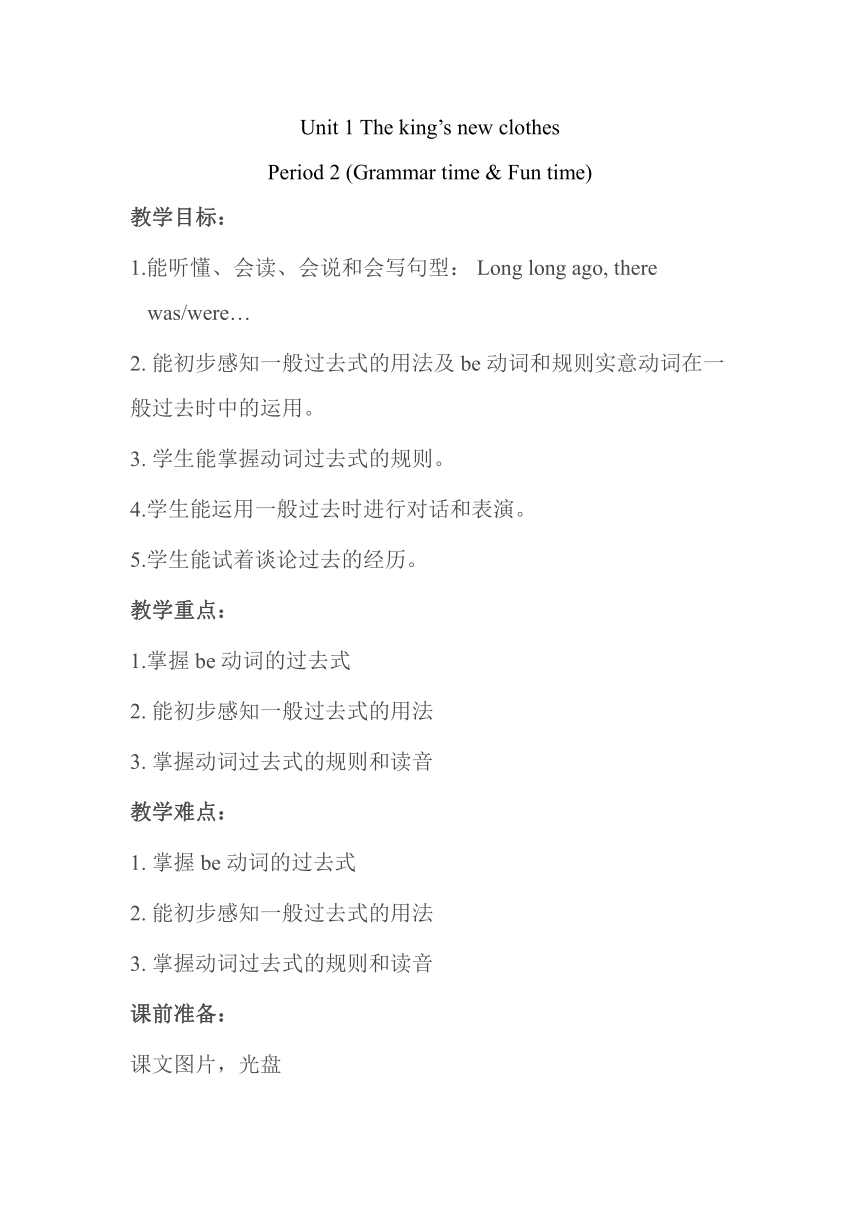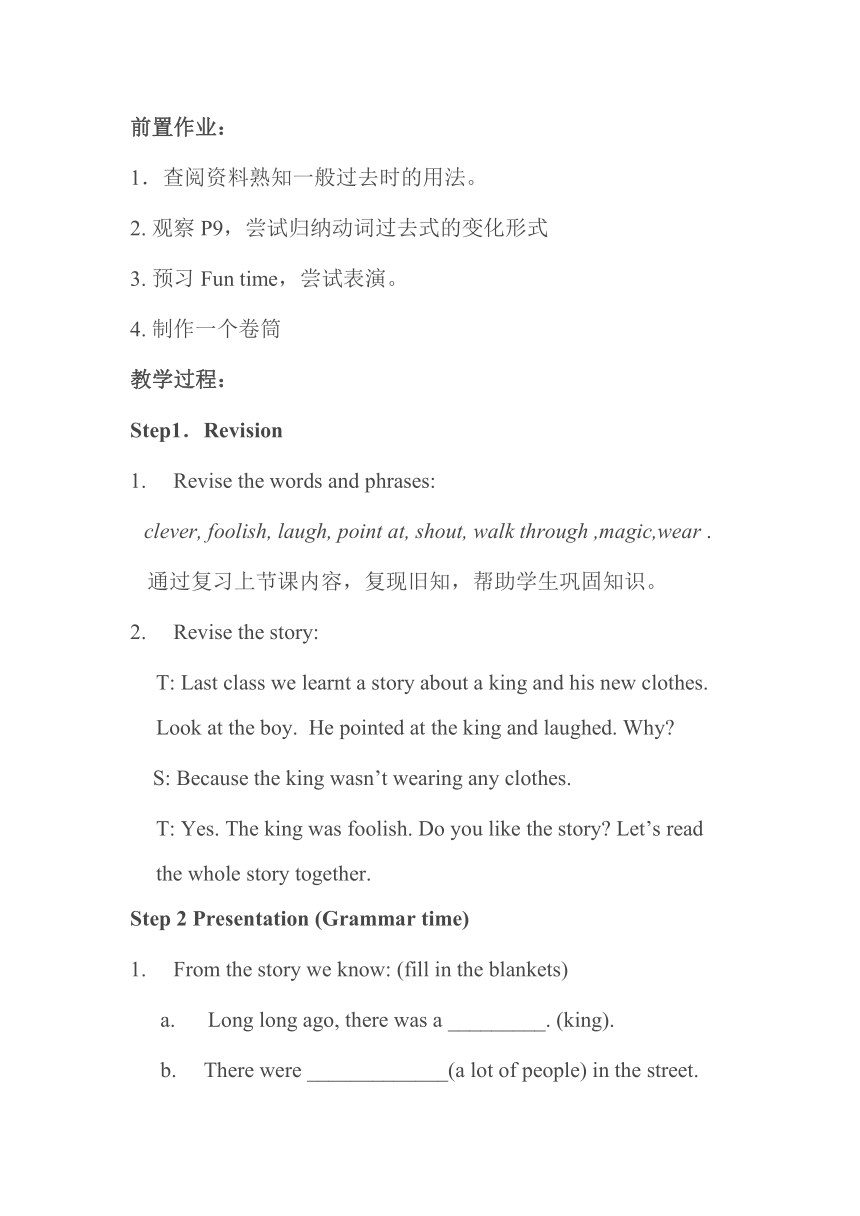Unit 1 The king’s new clothes Period 2 (Grammar time & Fun time)教案
文档属性
| 名称 | Unit 1 The king’s new clothes Period 2 (Grammar time & Fun time)教案 |  | |
| 格式 | docx | ||
| 文件大小 | 20.6KB | ||
| 资源类型 | 教案 | ||
| 版本资源 | 牛津译林版 | ||
| 科目 | 英语 | ||
| 更新时间 | 2024-07-20 11:24:14 | ||
图片预览



文档简介
Unit 1 The king’s new clothes
Period 2 (Grammar time & Fun time)
教学目标:
1.能听懂、会读、会说和会写句型: Long long ago, there was/were…
2. 能初步感知一般过去式的用法及be动词和规则实意动词在一般过去时中的运用。
3. 学生能掌握动词过去式的规则。
4.学生能运用一般过去时进行对话和表演。
5.学生能试着谈论过去的经历。
教学重点:
1.掌握be动词的过去式
2. 能初步感知一般过去式的用法
3. 掌握动词过去式的规则和读音
教学难点:
1. 掌握be动词的过去式
2. 能初步感知一般过去式的用法
3. 掌握动词过去式的规则和读音
课前准备:
课文图片,光盘
前置作业:
1.查阅资料熟知一般过去时的用法。
2. 观察P9,尝试归纳动词过去式的变化形式
3. 预习Fun time,尝试表演。
4. 制作一个卷筒
教学过程:
Step1.Revision
1. Revise the words and phrases:
clever, foolish, laugh, point at, shout, walk through ,magic,wear .
通过复习上节课内容,复现旧知,帮助学生巩固知识。
2. Revise the story:
T: Last class we learnt a story about a king and his new clothes. Look at the boy. He pointed at the king and laughed. Why
S: Because the king wasn’t wearing any clothes.
T: Yes. The king was foolish. Do you like the story Let’s read the whole story together.
Step 2 Presentation (Grammar time)
1. From the story we know: (fill in the blankets)
a. Long long ago, there was a _________. (king).
b. There were _____________(a lot of people) in the street.
c. One day, two men _______(visited) the king.
d. The king was _______(happy).
e. The king ______(liked) the new clothes.
f. They looked at the king and ________(shouted)/
g. A little boy pointed at the king and ________(laughed).
2. 将上述句子及下列句子分发给每个小组,每组员任选两句有感情的读,互帮互助要读正确。
h. Long long ago, I lived in Suzhou.
i. I liked apples very much when I was two.
3. T: From the story we know Long long ago, there was a king. The king liked new clothes. Who can read the words and sentences like this.
教师示范朗读,纠正发音,学生练习读。
板书is-was, like- liked。
学生在小组里读一读
4. Underline the words was, were, visited, liked, looked, pointed shouted, laughed.划出句中的动词过去式。
try to read these words correctly
5. 学生组内朗读,互相纠正读音,并将动词过去式发/d/,/t/,/id/归为一类。
6. 小组讨论,如何使用一般过去时。小组代表发言总结。
1)一般过去时表示过去某个时间发生的动作或存在的状态,常和表示过去的时间状语连用。一般过去时也表示过去经常或反复发生的动作。引导学生找出句子中的时间标志语,并板书。 long long ago, one day。补充:yesterday, last night, three days ago。
2)Be动词在一般过去时中的变化:am 和is在一般过去时中变为was。⑵are在一般过去时中变为were
3)动词过去式变化规则:
一般在动词末尾加-ed,如:point-pointed, shout-shouted
以不发音的e结尾加-d,如:like-liked live-lived
4) 过去式“-ed”的发音规则
(1)动词词尾为“t,d”时,发/ id /音,
want →wanted (要)need →needed (需要)
(2)动词词尾为清辅音时,发/ t / 音。
help →helped (帮助)laugh →laughed (笑)look →looked (看)
kiss →kissed (吻)wash →washed (洗) watch →watched (注视)
(3)动词词尾为t,d以外之浊辅音或元音时,发/ d /音。
call →called (叫)stay→stayed(停留)cry→cried(哭)
7. 呈现紫色部分的动词及其过去式,在组内读一读并互相纠正发音。
Step 3 Practice
1. Work in groups: 读一读,归归类
/t/: watched, picked, liked, hoped, stopped, walked, looked,laughed
/d/:watered, played, stayed, lived, showed
/id/: pointed, shouted, planted, visited, started
2. 师按类领读单词,注意发音
Step 4 Consolidation
1. 通过课文图片的展示,引导学生以King 和Man1,Man2等的口气进行对话。教师可先与一名学生做示范。
a. Pair work.学生两人一组进行对话练习。
b.act the dialogues.
2. 根据关键词复述故事。
Pic.1 Log long ago, there was … He liked … One day… visited … The king was …
Pic.2 The two men showed … Clever people… Foolish people …
Pic.3 The king walked through … There were … They looked at …shouted …
Pic.4 A little boy pointed …laughed …
3. T: Now boys and girls, you can read and act the story. Let’s try to write the story, OK
4.Choose one picture to write. 选择一幅图写一写。
Step 5 Homework
1. Read the story again.
2. Pre-read : Sound time
3. Surf the Internet and find some information about American cowboys and Scottish men.
板书设计:
Unit 1 The king’s new clothes
动词过去式变化规则:
1.一般在动词末尾加-ed,如:point-pointed, shout-shouted
2.以不发音的e结尾加-d,如:like-liked live-lived
过去式“-ed”的发音规则
(1)动词词尾为“t,d”时,发/ id /音,
(2)动词词尾为清辅音时,发/ t / 音。
(3)动词词尾为t,d以外之浊辅音或元音时,发/ d /音。
Period 2 (Grammar time & Fun time)
教学目标:
1.能听懂、会读、会说和会写句型: Long long ago, there was/were…
2. 能初步感知一般过去式的用法及be动词和规则实意动词在一般过去时中的运用。
3. 学生能掌握动词过去式的规则。
4.学生能运用一般过去时进行对话和表演。
5.学生能试着谈论过去的经历。
教学重点:
1.掌握be动词的过去式
2. 能初步感知一般过去式的用法
3. 掌握动词过去式的规则和读音
教学难点:
1. 掌握be动词的过去式
2. 能初步感知一般过去式的用法
3. 掌握动词过去式的规则和读音
课前准备:
课文图片,光盘
前置作业:
1.查阅资料熟知一般过去时的用法。
2. 观察P9,尝试归纳动词过去式的变化形式
3. 预习Fun time,尝试表演。
4. 制作一个卷筒
教学过程:
Step1.Revision
1. Revise the words and phrases:
clever, foolish, laugh, point at, shout, walk through ,magic,wear .
通过复习上节课内容,复现旧知,帮助学生巩固知识。
2. Revise the story:
T: Last class we learnt a story about a king and his new clothes. Look at the boy. He pointed at the king and laughed. Why
S: Because the king wasn’t wearing any clothes.
T: Yes. The king was foolish. Do you like the story Let’s read the whole story together.
Step 2 Presentation (Grammar time)
1. From the story we know: (fill in the blankets)
a. Long long ago, there was a _________. (king).
b. There were _____________(a lot of people) in the street.
c. One day, two men _______(visited) the king.
d. The king was _______(happy).
e. The king ______(liked) the new clothes.
f. They looked at the king and ________(shouted)/
g. A little boy pointed at the king and ________(laughed).
2. 将上述句子及下列句子分发给每个小组,每组员任选两句有感情的读,互帮互助要读正确。
h. Long long ago, I lived in Suzhou.
i. I liked apples very much when I was two.
3. T: From the story we know Long long ago, there was a king. The king liked new clothes. Who can read the words and sentences like this.
教师示范朗读,纠正发音,学生练习读。
板书is-was, like- liked。
学生在小组里读一读
4. Underline the words was, were, visited, liked, looked, pointed shouted, laughed.划出句中的动词过去式。
try to read these words correctly
5. 学生组内朗读,互相纠正读音,并将动词过去式发/d/,/t/,/id/归为一类。
6. 小组讨论,如何使用一般过去时。小组代表发言总结。
1)一般过去时表示过去某个时间发生的动作或存在的状态,常和表示过去的时间状语连用。一般过去时也表示过去经常或反复发生的动作。引导学生找出句子中的时间标志语,并板书。 long long ago, one day。补充:yesterday, last night, three days ago。
2)Be动词在一般过去时中的变化:am 和is在一般过去时中变为was。⑵are在一般过去时中变为were
3)动词过去式变化规则:
一般在动词末尾加-ed,如:point-pointed, shout-shouted
以不发音的e结尾加-d,如:like-liked live-lived
4) 过去式“-ed”的发音规则
(1)动词词尾为“t,d”时,发/ id /音,
want →wanted (要)need →needed (需要)
(2)动词词尾为清辅音时,发/ t / 音。
help →helped (帮助)laugh →laughed (笑)look →looked (看)
kiss →kissed (吻)wash →washed (洗) watch →watched (注视)
(3)动词词尾为t,d以外之浊辅音或元音时,发/ d /音。
call →called (叫)stay→stayed(停留)cry→cried(哭)
7. 呈现紫色部分的动词及其过去式,在组内读一读并互相纠正发音。
Step 3 Practice
1. Work in groups: 读一读,归归类
/t/: watched, picked, liked, hoped, stopped, walked, looked,laughed
/d/:watered, played, stayed, lived, showed
/id/: pointed, shouted, planted, visited, started
2. 师按类领读单词,注意发音
Step 4 Consolidation
1. 通过课文图片的展示,引导学生以King 和Man1,Man2等的口气进行对话。教师可先与一名学生做示范。
a. Pair work.学生两人一组进行对话练习。
b.act the dialogues.
2. 根据关键词复述故事。
Pic.1 Log long ago, there was … He liked … One day… visited … The king was …
Pic.2 The two men showed … Clever people… Foolish people …
Pic.3 The king walked through … There were … They looked at …shouted …
Pic.4 A little boy pointed …laughed …
3. T: Now boys and girls, you can read and act the story. Let’s try to write the story, OK
4.Choose one picture to write. 选择一幅图写一写。
Step 5 Homework
1. Read the story again.
2. Pre-read : Sound time
3. Surf the Internet and find some information about American cowboys and Scottish men.
板书设计:
Unit 1 The king’s new clothes
动词过去式变化规则:
1.一般在动词末尾加-ed,如:point-pointed, shout-shouted
2.以不发音的e结尾加-d,如:like-liked live-lived
过去式“-ed”的发音规则
(1)动词词尾为“t,d”时,发/ id /音,
(2)动词词尾为清辅音时,发/ t / 音。
(3)动词词尾为t,d以外之浊辅音或元音时,发/ d /音。
